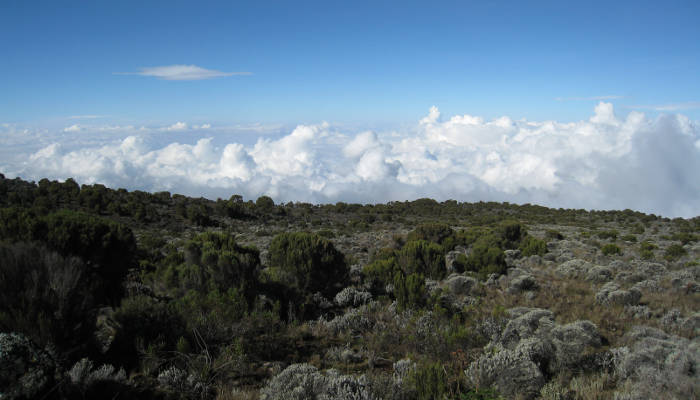KILIMANJARO WEATHER
Kilimanjaro weather – dominant trade and anti-trade winds – Kilimanjaro’s climatic zones – the South-east trade winds and North-east anti-trade winds.
Because Mount Kilimanjaro is such a large geographic structure it essentially creates its own weather.
In this article we have provided an overview on the types of weather you can expect on Kilimanjaro, as well outlined historical Kilimanjaro weather patterns for each of Kilimanjaro’s climatic zones.
TRADE AND ANTI-TRADE WINDS
Kilimanjaro weather can best be understood by studying the the dominant trade and anti-trade winds that pass through the region.
Why?
Because winds carry moisture from the ocean. When they hit large objects, like mountains, they rise, cool and condense, forming clouds and precipitation (i.e. rain and snow).
There are two main winds that drive weather patterns on Mount Kilimanjaro – the South-east trade winds and North-east anti-trade winds. We explain the influence of each wind below.
World map showing SE and NE Trade Winds
South-east trade winds
The South-East trade winds from the Indian Ocean arrive around mid March and last well into May (before being interrupted by the North-East Anti trade winds). These winds carry loads of moisture from the Indian ocean so when they eventually hit the massive structure of Mount Kilimanjaro and are forced upwards, they form large rain clouds and the ‘heavens open’.
Mid-March through to the end of May is therefore the wet season on Mount Kilimanjaro and not a great time for trekking.
That being said, as these winds blow from the South most of the rain falls on the southern side of Kilimanjaro. The Northern slopes tend to be buffeted from the winds and therefore receive considerably less rain during this time of the year.
If one wants to trek in March-May it is best to consider the Rongai Route which follows a trail from the North.
North-East anti-trade winds
Anti-trade winds from the North-East arrive between late May and last through to early November and don’t carry rain as they lose their moisture well before hitting Kilimanjaro. They generally blow quite strongly forcing their way through the Saddle (the valley between Kilimanjaro’s two peaks – Kibo and Mawenzi).
As the strong anti-trade winds pass through the saddle they force the South-East winds down below them. Hence during the dry season (June through to October) cloud cover and some rain is common up to the 3,000 meter mark on the southern slopes but quickly disappears above this altitude.

The dynamic between the strong and dry North-east trade-winds and the less powerful South-east winds, means that late May through to the end of October is a great time to trek as rain is rare and usually confined to the lower southern slopes.
May through to October also coincides with the summer holiday periods of the Northern Hemisphere so the slopes of Kilimanjaro can be busy at this time of the year.
North-East Monsoon
The North-East Monsoon arrives around mid November and lasts through to February. These winds have travelled a long way over the continent and don’t have a high moisture content which means that the season is generally quite light on rain.
Most of this rain falls on the lower northern slopes of Mount Kilimanjaro, but is a lot lighter than the main wet season brought by the South-east winds in March-May.
The interaction of these winds with Mount Kilimanjaro mean that there are two main trekking seasons – January-March and June-October.



